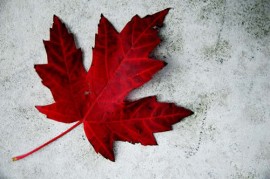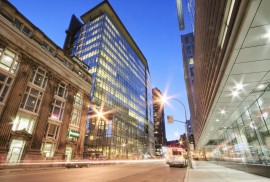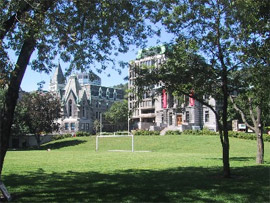
A land of vast distances and rich natural resources, Canada is the second-largest country in the world after Russia.It became a self-governing dominion in 1867 while retaining ties to the British crown. Since World War II, the impressive growth of the manufacturing, mining, and service sectors has transformed the nation from a largely rural economy into one primarily industrial and urban.Canada is a high-tech industrial society, newly entered in the trillion dollar class with market-oriented economic system, production and high living standards.Economically and technologically the nation has developed in parallel with the US, its neighbour to the south across an unfortified border. Approximately 90% of the population is concentrated within 160 km of the US border that absorbs more than 85% of Canadian export.
Given its great natural resources, skilled labour force, and modern capital plant Canada enjoys firm economic prospects. Solid fiscal management has produced a long-term budget surplus, which is substantially reducing the national debt.
Construction industry is expanding nowadays – 200000 units of residential and commercial units are being built every year. Despite the saturated market Canada is still attractive for the investors.There are no limitations for non-residents to purchase real estate in Canada. Unlike a rank of European countries, foreigners may invest for both residential and commercial purposes.
 Montreal is one of North America’s oldest cities. Its architectural heritage is one of the richest and most diverse of any city in North America. Few others bear as many traces of the different periods of their evolution: prehistory, the French regime, the British era, the industrial and financial metropolis and the modern city. Montreal’s built heritage expresses itself in many different ways. Squares and parks, industrial areas, neighborhoods and commercial streets are only some examples of the diversity that is very much Montreal.
Montreal is one of North America’s oldest cities. Its architectural heritage is one of the richest and most diverse of any city in North America. Few others bear as many traces of the different periods of their evolution: prehistory, the French regime, the British era, the industrial and financial metropolis and the modern city. Montreal’s built heritage expresses itself in many different ways. Squares and parks, industrial areas, neighborhoods and commercial streets are only some examples of the diversity that is very much Montreal.
A significant part of Montreal’s buildings were constructed in the intense period of development that marked the end of the 19th century. The city’s economic activity was controlled by the English-Scottish elite whose great houses sprung up on the south-facing slopes of Mount Royal in the area known as the Square Mile. The architecture of these mansions is evidence of the opulence and variety that characterised the Victorian era.
 This is the first time I ever was in a city where you couldn’t throw a brick without breaking a church window” wrote Mark Twain during his stay in Montreal in 1881. Even though Notre Dame Church retained its place as the most important of the Catholic churches, the 19th century was a period of intense activity which saw the creation of many parishes and the construction of many churches. Often constructed in a more modest architectural style, but no less remarkable, were the Protestant churches and the synagogues which were built throughout the city.
This is the first time I ever was in a city where you couldn’t throw a brick without breaking a church window” wrote Mark Twain during his stay in Montreal in 1881. Even though Notre Dame Church retained its place as the most important of the Catholic churches, the 19th century was a period of intense activity which saw the creation of many parishes and the construction of many churches. Often constructed in a more modest architectural style, but no less remarkable, were the Protestant churches and the synagogues which were built throughout the city.
Over time, the churches have become the focal points of their neighbourhoods and a repository of sacred art of great value.
From 1850 onwards, Montreal firmly took its place as the economic heart of Canada. The hub of the railway system and the shipping industry, Montreal was transformed by the infrastructure and buildings necessary to support these industries.
At the height of industrialisation, trees were also planted along streets throughout the city and parks and squares laid out based on British and American planning principles.
Frederick Law Olmsted, best known for landscaping New York’s Central Park, drew the design plans for Mount Royal Park in an age where he was considered the most famous landscape architect in North America.
Many people come to Montreal to shop in its wide range of international boutiques, and Canada’s low dollar makes it especially attractive for Americans to shop here.
The most famous aspect of shopping in Montreal is the Underground City. Constantly growing, the “city” – which links many major buildings and multi-level shopping malls in the area – is a shopper’s paradise in any season. One major section is reached via Peel and McGill metro stations on the green line, and another via Bonaventure station on the orange line. East of McGill station is a growing axis from Place-des-Arts metro down through Complexe Desjardins and beyond.
Safe and sheltered from the elements, the Underground City offers a huge range of goods and services as well as a handy way to get from place to place without weather or traffic problems.
 Montreal is home to 11 institutions of higher learning that offer a variety of internationally recognized training programs, specifically in the leading high-tech industries (aerospace, life sciences and information technologies). These institutions of higher learning include four major universities: McGill University and Concordia University, the two English-language institutions, and the Université de Montréal and UQAM, the two French-language institutions.
Montreal is home to 11 institutions of higher learning that offer a variety of internationally recognized training programs, specifically in the leading high-tech industries (aerospace, life sciences and information technologies). These institutions of higher learning include four major universities: McGill University and Concordia University, the two English-language institutions, and the Université de Montréal and UQAM, the two French-language institutions.
Every year, Montreal attracts many foreign students. In 2003 alone, 17,000 foreigners were in attendance at our institutions of higher learning, a fact that attests to the quality of our instruction and the excellent reputation of our programs – not to mention that tuition fees at our universities are among the lowest in all of North America!
In Montreal, education is at the heart of our priorities.

